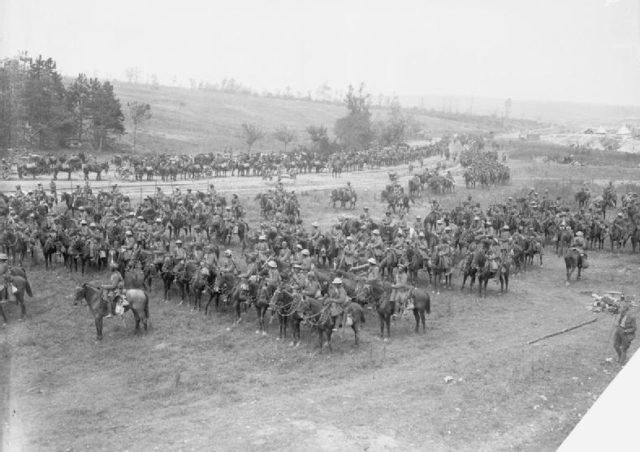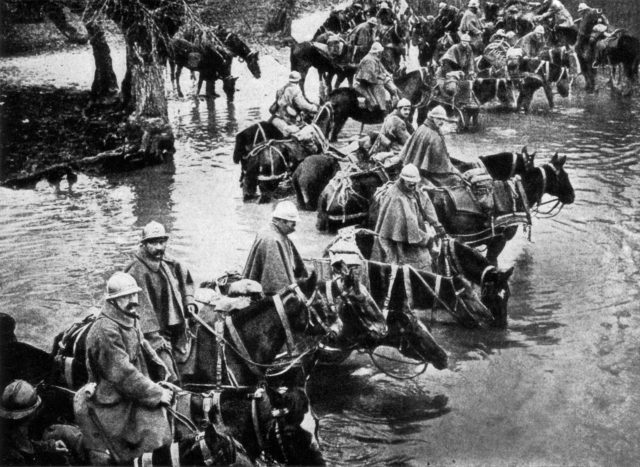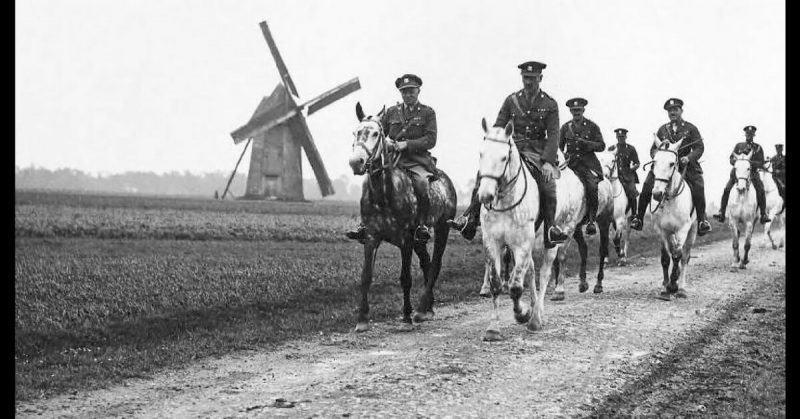WWI is widely regarded as the end of cavalry warfare. Changes in technology had made mounted soldiers a liability, instead of the hard-hitting asset they had been for thousands of years.
Although that view is broadly accurate, it hides a more complex reality in which the effectiveness of cavalry varied with time and place across the war.
Expectations and Technology
At the start of WWI, many generals expected the cavalry would play an important part. Field Marshal Sir Douglas Haig, who commanded the British forces on the Western Front for most of the war, was a firm believer in the cavalry. His strategy throughout was to wear down the enemy and break a hole in their lines so the cavalry could pour through.
That view, common among other commanders, showed how little they understood about the weapons of the era. Machine guns, fast firing rifles, artillery, and barbed wire were about to change the face of war in Europe.
Opening Clashes
The opening clashes of the war saw cavalry used in its traditional role. Mounted men were sent ahead to scout out the terrain and enemy formations. They sometimes formed bridgeheads into which other troops could advance.
One of the most successful expeditions was led by the German Lieutenant Hyazinth von Strachwitz, later a Panzer commander in WWII. The 21-year-old Strachwitz, a Guards Cavalry officer, volunteered for a dangerous long-range patrol. With 16 hand-picked men, he spent six weeks roaming around behind the French army, gathering intelligence, cutting telegraph lines, and blowing up rail tracks. They created fear in Paris and diverted soldiers to hunt them down. They were eventually captured but had achieved a lot.
There were fights between cavalry troops. On September 6, 1914, the German 1st Guard Dragoons fought the British 9th Lancers at Moncel.
Trenches on the Western Front
A few days after the clash at Moncel, another encounter showed which way the wind was blowing.
The British 18th Hussars fought against a group of 70 German cavalry. The dismounted Hussars fired devastating rifle volleys at the charging Germans, killing or wounding nearly all of them. Even without the hail of fire a machine-gun could discharge, men with modern weapons could annihilate a cavalry charge.
As the war in the west developed, trench lines, barbed wire, and machine gun nests gave an even greater advantage to infantry on the defensive. It would be suicidal for the cavalry to charge through such conditions.
Commanders kept the cavalry in reserve while waiting for the breakthrough they were sure would come. As months and then years rolled by, the cavalrymen were taken off their horses and fielded to fill gaps in the infantry lines.

The Eastern Front
Things were different on the Eastern Front. The war zone covered an enormous distance from the Romanian frontier to the coast of the Baltic Sea. Trench lines did not develop to fill the vast space.
As a result, the war was much more mobile. Cavalry continued to play a part, as they had done in the early days in the west. Austria-Hungary, Germany, and Russia successfully used mounted troops.
Palestine
The area of the conflict which featured the most cavalry was Palestine. There, the Allies sought the aid of Arab rebels in their fight against the Ottoman Turks.
Again, wide open spaces favored cavalry. It was not the massive siege warfare of the Western Front. It was a war of movement and raiding.
From early on, the British fielded several mounted units in Palestine. They came from across the Empire. Australians, Britons, Indians, and New Zealanders all mounted up. Alongside them, Arabs fought almost entirely from their horses or camels. French cavalry also joined the fray.
A lot of the time, the troops used their horses to travel then dismounted to fight, as the 18th Hussars had done so successfully in Europe in September 1914. There were still occurrences of more old-fashioned fighting. In late 1917, the 4th and 12th Australian Light Horse charged a Turkish trench position across 3,000 yards of open ground. They did not have swords, so galloped with their bayonets drawn. The Turks, terrified by the sight, fled rather than hold their trenches.

1918 on the Western Front
It was on the Western Front, however, that the future of war was being laid down. There, the most advanced and expensive weapons were deployed. Weapons were extensively tried out which later shaped the way war was fought across the world.
In 1918, the Western Front changed. The German Spring Offensives broke the stalemate. A war of movement returned. After the German advance failed, the Allies went on the attack.
With the lines opening up, the generals tried to deploy cavalry again. However, their vulnerability to fast-firing modern infantry weapons had already been shown. Experiments were carried out in using them alongside tanks, with the two fast-moving types of forces supporting each other. The ground suitable for tanks was different from what suited cavalry. Often one left the other behind. Even paired with the newest weapons, cavalry was proving obsolete.
Not the End, But an Omen
The general trend was a move away from cavalry. WWI had showcased the weapons that would dominate the future, and they were devastating to a vulnerable man on a horse. The war did not provide a definite, sudden end to the usefulness of cavalry. In the right conditions; they were useful, as in Palestine. Even in WWII, the Russians still used some cavalry.
WWI was not the end of the cavalry, but it heralded the approach of the end.
Sources:
James Lucas (1996), Hitler’s Enforcers: Leaders of the German War Machine 1939-1945
Ian Westwell (2008), World War I
